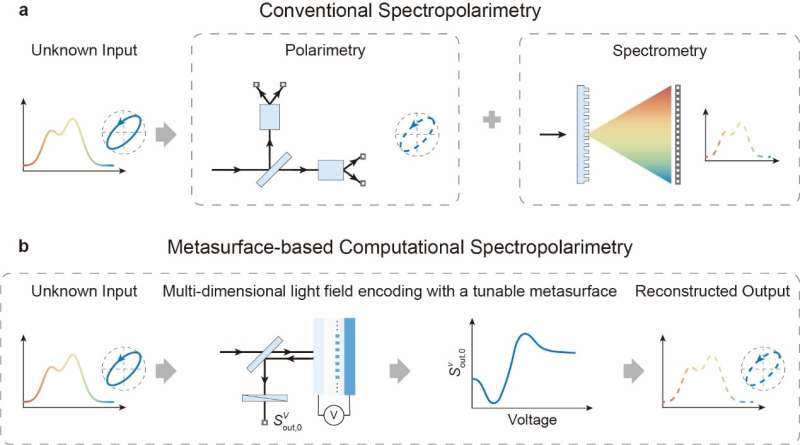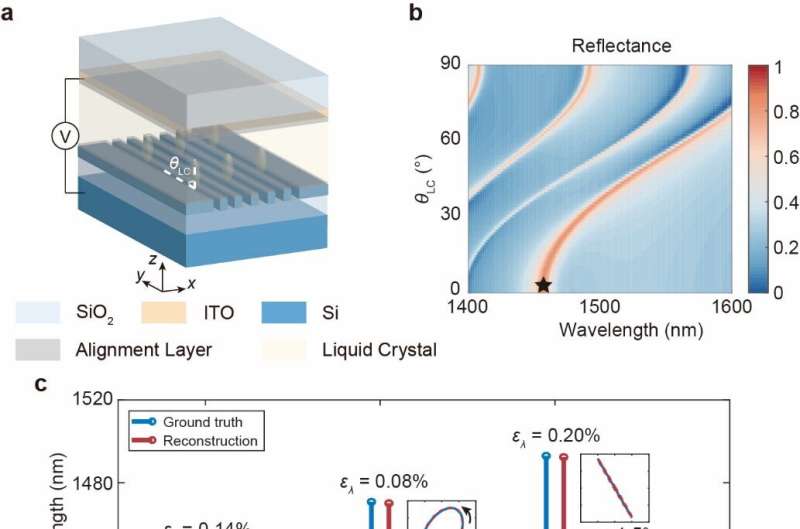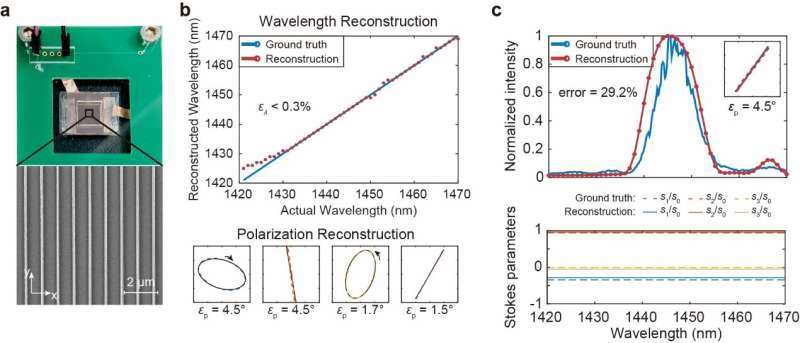Liquid crystal metasurface could enable multi-dimensional light field sensing

While conventional photodetectors can only measure light intensity, the light field contains much richer information. This information includes but is not limited to phase, polarization, and spectrum.
The measurement of multi-dimensional light field information can find its application in various fields. For instance, polarization measurements can reveal objects' material composition and surface textures. Spectral analysis can be instrumental for chemical study and wavelength-division-based telecommunication.
Conventional polarimeters and spectrometers are often bulky, which hinders their applications in miniaturized platforms. Division-of-amplitude polarimeters and spectrometers utilize polarization beam splitters and dispersive elements. These are designed to spatially separate and distinguish light with different polarization and wavelengths.
Alternatively, division-of-time polarimeters and spectrometers take advantage of tunable polarization and wavelength filters to sequentially measure light intensity with different polarization and spectral components. Through the multiplexing of polarization and spectrum detection mechanisms, composite systems that can simultaneously measure the polarization and spectrum of light have been developed recently. However, the multiplexing inevitably results in a further increased system form factor and complexity.
In a new paper published in eLight, a team of scientists, led by Professor Yuanmu Yang from the State Key Laboratory of Precision Measurement Technology and Instruments, Department of Precision Instruments, Tsinghua University, have developed a near-infrared spectropolarimeter based on an electrically-tunable liquid crystal metasurface.
The paper, titled "Computational spectropolarimetry with a tunable liquid crystal metasurface," showed how simultaneous polarization and spectral measurements are achieved through a tunable metasurface with high-quality-factor guided-mode resonances combined with a computational reconstruction algorithm.

The metasurface is an emerging class of planar diffractive optical elements. Its design flexibility has broken new ground for manipulating the vectorial light field. Metasurface-based polarimeters and spectrometers have been developed in recent years. Computational polarimeters and spectrometers have also been demonstrated. These devices have shown how the polarization or spectrum of the incident light can be encoded using a tunable graphene-integrated metasurface or metasurface array.
The simultaneous multiplexing and reconstruction of multi-dimensional light field information remain challenging. Metasurface-based spectropolarimetry has been demonstrated by spatially splitting the incident light with different polarization components and wavelengths. However, such an approach requires a detector array for polarization and spectrum detection at a single spatial location. It prevents its use for spectropolarimetric imaging.

The researchers proposed and experimentally demonstrated a spectropolarimeter that simultaneously measures the polarization and spectrum of near-infrared light. The core hardware of the system is an electrically-tunable liquid crystal-embedded silicon metasurface. The metasurface is tailored to support multiple high-quality-factor guided mode resonances.
The metasurface has rich and anisotropic spectral features that can be widely tuned by applying different bias voltages. The system can reconstruct the incident light's full Stokes parameters and spectrum from the reflected light intensity recorded by a single-pixel photodetector. The fabrication of the liquid crystal metasurface is fully compatible with the complementary metal-oxide semiconductor (CMOS) and liquid crystal on silicon (LCoS) manufacturing process. That means the system may be mass-produced at a low cost.
The demonstration of a tunable metasurface-based multi-dimensional light field encoder allows simultaneous measurement of the polarization and spectrum of near-infrared light. The metasurface encodes the polarization and spectral information using its anisotropic high-Q guided-mode resonances. Although the liquid crystal metasurface currently operates in the reflection mode, one can also design a transmissive liquid crystal metasurface to enable more compact integration with the photodetector.
When integrated with a proper detector array, the liquid crystal metasurface may be used for spectropolarimetric imaging without sacrificing spatial resolution. The proposed liquid crystal metasurface may be used in many applications that require polarization and spectral measurements, such as in biomedical imaging, remote sensing, and optical communication. Such a strategy may also be extended to construct compact systems that can measure additional light field information, such as the depth of a target scene or the wavefront of the incident light.
More information: Yibo Ni et al, Computational spectropolarimetry with a tunable liquid crystal metasurface, eLight (2022). DOI: 10.1186/s43593-022-00032-0
Provided by Chinese Academy of Sciences





















